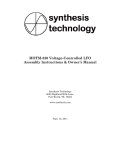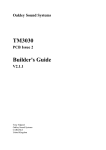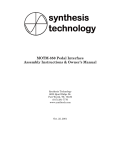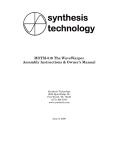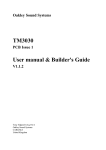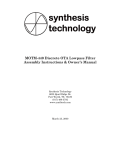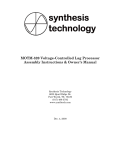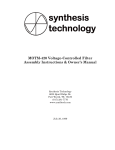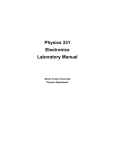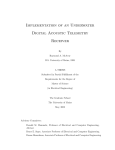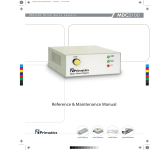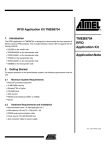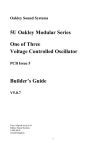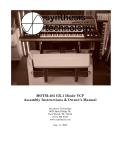Download MOTM-490 User Manual
Transcript
MOTM-490 Micro Voltage-Controlled Filter Assembly Instructions & Owner’s Manual Synthesis Technology 6625 Quail Ridge Dr. Fort Worth, TX 76180 (817) 498-3782 www.synthtech.com Aug. 22, 2005 MOTM-490 PARTS LIST Please carefully check that all parts are in your kit. If you have a suspected shortage, please call or email. If you get free extra stuff, keep it for next time. Capacitor bag, containing the following 15 parts (C1-C6 not used): 3ea 10mf, 50V Electrolytic 1ea 220mf, 10V Electrolytic 2ea 1mfd, 50V non-polar Electrolytic 1ea 22pf (marked 220) ceramic axial 1ea 220nf film (reddish-brown, marked 224) cap 1ea 1nf yellow box cap 4ea 100nf film (reddish-brown, marked 104) cap 2ea 0.1mfd (marked 104) ceramic axial C7, C8, C21 C15 C13, C20 C10 C12 C14 C16 – C19 C9, C11 Resistor bag, containing the following 33 parts (5% unless noted): 7ea 1K (brown, black, red) 3ea 100K 1% (brown, black, black, orange) 3ea 10K (brown, black, orange) 3ea 15K (brown, green, orange) 2ea 22K (red, red, orange) 2ea 2K7 (red, violet, red) 2ea 360Ω (orange, blue, brown) 2ea 680Ω ( blue, gray, brown) 1ea 470K (yellow, violet, yellow) 1ea 270K (red, violet, yellow) 1ea 12K (brown, red, orange) 1ea 200K (red, black, yellow) 1ea 3K (orange, black, red) 1ea 680K (blue, gray, yellow) 1ea 127K 1% (brown, red, violet, orange) 1ea 39K (orange, white, orange) 1ea 16K (brown, blue, orange) R6, R15-R18, R27, R33 R5, R23, R32 R11, R12, R13 R3, R28, R31 R4, R26 R14, R19 R20, R21 R24, R25 R1 R2 R7 R8 R9 R10 R22 R29 (see text for possible mod) R30 IC bag, containing the following 13 parts: 2ea SSM2210 NPN matched pair 7ea BC550C NPN transistor 2ea BC560C PNP transistor 1ea 1N4148 diode 1ea NE5517 dual OTA SYNTHESIS TECHNOLOGY MOTM-490 ASSEMBLY 7/25/02 WWW.SYNTHTECH.COM Q1, Q2 Q3, Q5 – Q10 Q4, Q11 D1 U1 PAGE 2 Misc #1 bag, containing the following 5 parts: 2ea Axial ferrite beads (plain, gray things) 1ea MTA-156 power connector 1ea trimmer, 100K Bourns 3386P 1ea trimmer, 20K Bourns 3386P L1, L2 JP1 TP1 TP2 Knobs, 3ea, ALCO PKES90B1/4 Jacks, 6ea Switchcraft 112A Pots, 3ea containing the following: 3ea 100K cermet Spectrol 149 VR1- VR3 Front panel Mounting bracket Wire bag, containing the following 7 wires: 3ea RG-174 coax, 4 ½ inches 1ea RG-174 coax, 7 inches 2ea 2-wire set, 22ga, 3 ½ inches (red/black) 1ea Power Cable, 20” Hardware bag, containing: 4ea #8-32 x 3/8 black screws (for mounting module to rack) 4ea #6-32 x 1/2 zinc screws (for attaching pc board to bracket) 4ea 1/4 inch aluminum spacers 4ea #6 KEPS nuts 5ea small tie-wraps Organic Solder No-clean Solder PC Board, MOTM-490 SYNTHESIS TECHNOLOGY MOTM-490 ASSEMBLY 7/25/02 WWW.SYNTHTECH.COM PAGE 3 GENERAL INFORMATION Thank you for purchasing the MOTM-490 Micro Voltage-Controlled Filter (VCF). If you have any issues concerning the building or use of the kit, please contact us at (817) 4983782 or by email: [email protected]. This kit should take the average builder between 2 to 3 hours. The VCF kit contains many different resistors and special parts that require very accurate soldering skills. However, please remember this is NOT a speed contest; it is an accuracy contest. There is no rule that you have to complete the entire kit in one day (as long as you wash the flux off!). Successful kit building relies on having the proper tools. Here is a list of what you will need to build your MOTM-490: * * * * * * * * * * * Soldering iron, 50W max power Needle-nose or chain-nose pliers Diagonal cutters Allen key set for securing the knobs (1/16” or 1.58mm) Magnifying glass: to read the capacitor codes and to inspect solder joints Lead bending tool (optional, but makes the job go much faster) DVM (Digital Volt Meter) or oscilloscope (to check the output) #1 Philips screwdriver Small, flat screwdriver for adjusting the trimmers Fingernail brush for washing off the organic flux Old towel for blotting dry pc board For more information of tools used and suggestions, see the MOTM FAQ and Tutorial pages at http://www.synthtech.com. HOW TO FOLLOW THE DIRECTIONS Please read the entire instruction before proceeding. There may be valuable information at next to it. After you the end of the instruction. Each instruction has a check box complete the instruction, check the box. This way you can keep track of where you are in the process. VERY IMPORTANT – PLEASE READ! It is critical that you follow the steps exactly in order for proper operation. This kit contains expensive, hard-to-find parts! Please read ALL of an instruction before proceeding. VERIFY THE PARTS LIST Verify that all of the parts are in the kit as shown on the parts list. SYNTHESIS TECHNOLOGY MOTM-490 ASSEMBLY 7/25/02 WWW.SYNTHTECH.COM PAGE 4 A WORD ON SOLDERING There are 2 very different types of solder used in the kit. Most of the soldering uses ‘Organic Flux’ solder. This is strictly for use on the pc board, and is NOT to be used on the front panel wiring! In order for solder to ‘stick’ to the copper, a chemical called ‘flux’ is embedded in the solder. The flux leaves a residue on the pc board that should be cleaned with warm water. DO NOT USE SOAP OR OTHER CLEANSERS. Most of the parts in the kits are ‘waterproof’ and can be washed in the sink. The flux is OSHA approved for flushing down the drain, so don’t worry about that! A soft brush is used to gently scrub the board. We recommend a ‘fingernail brush’, which is about 1” x 2” and can be found for about $1. The other type of solder is called ‘No Clean Flux’; because as the name implies it does, not require washing. This solder is used for wiring the pots, switches, jacks, etc. This solder is harder to use on the pc board; because even when melted, it is not very fluid (about the consistency of toothpaste). We will use it VERY SPARINGLY on the pc board. OK, let’s get started on the board! PART #1: SOLDERING THE RESISTORS Since there are more resistors than anything else, we will start here. If you do not know the resistor color code, refer to the parts list. Resistors are not polarity sensitive, but the board will be easier to debug (and look nicer) if you point the first color band in the same direction for all the parts. The color code is also in the README FIRST document that every customer receives with his or her first order. There are 2 types of resistors in the MOTM-490 kit: standard 5%, 1/4W parts and 1%, 1/4W resistors with an ‘extra’ color band. The precision parts use a slightly different color-coding scheme. If you are unsure of a resistor’s value, use your trusty DVM to measure it! Inserting the wrong resistor in the VCF kit will cause interesting behavior! And, it’s very hard to find the error. You will start by soldering in ALL of the resistors. Find the RESISTOR bag. Find the MOTM-490 blank pc board. There is a copy (larger than actual size) of the silkscreen which shows where the parts go at the end of this document. It will be useful if you locate the part on the print first, put the part in the board, then ‘check off’ the silkscreen. All parts are inserted from the side of the board with the white silkscreen (the “top” side). We will stuff the resistors by value to make things easier. The resistors (and other long-leaded parts) are inserted on a 0.4 inch spacing. The important thing is to be sure that the part is sitting all the way down on the board. Push the leads in the holes, push the part on the board, and then bend the leads on the bottom outwards SYNTHESIS TECHNOLOGY MOTM-490 ASSEMBLY 7/25/02 WWW.SYNTHTECH.COM PAGE 5 to a 45 degree angle (roughly!). This is called ‘cinching the leads’: and keeps the part from falling out! From the bottom of the board, solder (using the organic flux), applying heat to the pad for about a half second first, then applying just enough solder to make a small puddle that looks like a tiny pyramid. Enough solder should flow in the hole such that on the top (component) side, a small amount is on the top pad as well. A SMALL AMOUNT, not a blob! The rule of soldering: don’t use too much, you can always add more! Cut the leads flush with the top of the solder joint with your diagonal cutters. This pc board has parts very close together. It may not be clear where a certain resistor or capacitor is. We will try to give you a “hint” for the hard-to-find parts! NOTE: you will need to save 2 of the resistor leads after you cut them! Don’t forget! Locate the 1K resistors (7) and solder into R6 (by C15), R15 – R18 (in a row, left of Q7), R27 (left of VR2), and R33 (left of R27). Locate the 100K 1% resistors (3) and solder into R5 (by C13), R23 (by TP2) and R32 (by C21). Locate the 10K resistors (3) and solder into R11 – R13 (in a row, beside Q2). Locate the 15K resistors (3) and solder into R3 (by J6), R28 (above Q11) and R31 (also by J6). Locate the 22K resistors (2) and solder into R4 (by C13) and R26 (below C12). PART #2: BOARD WASH #1 Verify all the resistors are in the correct position. Verify all the resistors are flat on the board. Correct if needed. Check solder joints. Wash the board in warm water, gently scrubbing both sides. Shake the board a couple of times, blot dry with an old towel (the leads will frazzle a good towel). Let dry about 15 minutes. SYNTHESIS TECHNOLOGY MOTM-490 ASSEMBLY 7/25/02 WWW.SYNTHTECH.COM PAGE 6 PART #3: Complete the Resistors Locate the 2K7 resistors (2) and solder into R14 (above Q1) and R19 (by C14). Locate the 360 ohm resistors (2) and solder into R20 (above Q2) and R21 (by C15). Locate the 680 ohm resistors (2) and solder into R24 and R25 (right of U1). Locate the 470K resistor and solder into R1 (by J5). Locate the 270K resistor and solder into R2 (below R1). Locate the 12K resistor and solder into R7 (by Q3). Locate the 200K resistor and solder into R8 (by Q10). Locate the 3K resistor and solder into R9 (below R8). Locate the 680K resistor and solder into R10 (above R9). Locate the 127K 1% resistor and solder into R22 (by TP2). Locate the 39K resistor and solder into R29 (below C12). Locate the 16K resistor and solder into R30 (by C20). This completes the resistors. Check your solder joints and wash the board again. Let dry 15 minutes. Take a little break! PART #4: CAPACITORS Locate the CAPACITOR bag. Note that the capacitors are numbered starting with C7. C1-C6 are not there (it’s a long story!). Locate the 22pf ceramic axial cap marked 22P or 220. Solder into C10 (by U1), Locate the 0.1mf axial ceramic caps (attached to the 2 pieces of removable tape) and solder into C9 and C11 (top/bottom of U1). Locate the 100nf stacked-metal film caps (4), marked 104. Solder into C16 – C19 (above VR1). SYNTHESIS TECHNOLOGY MOTM-490 ASSEMBLY 7/25/02 WWW.SYNTHTECH.COM PAGE 7 Locate the 220nf stacked-metal film cap marked 224. Solder into C12 (below TP2). Locate the 1nf (0.001mf) yellow box cap and solder into C14 (by Q9). Locate the 1md, 50V non-polar electrolytic caps (2). The lead orientation is not important (it’s a non-polar cap, after all). Solder into C13 (by C8) and C20 (above Q1). Locate the 10µfd electrolytics (3). Note that there is a stripe on the NEGATIVE terminal. The pc board has a + on the POSITIVE terminal. Carefully stick the capacitors into C7, C8 and C21 with the stripe away from the + pad on the board. Solder the 220mfd electrolytic cap into C15, again observing proper polarity. Check to be sure all 4 electrolytic caps have their stripes facing the SAME WAY. Wash the board again, gently scrubbing both sides. Use ONLY warm water! PART #5: MISC and IC STUFF Almost done with the parts on the pc board! This will finish up the soldering with the organic flux. Locate the MISC #1 bag and the IC bag. Locate the ferrite beads (2). They are axial parts, gray colored with no markings. These are non-polar, and are soldered into L1 and L2. Locate the MTA-156 power connector. Solder into JP1. Note that the connector has a ‘locking tab’ on one side. This side is the “inside” facing relative to the pc board. Note the silkscreen symbol for JP1 has a line on one side, indicating this is the side where the locking tab goes. Locate the 2ea SSM2210s (they look like ICs). Solder into Q1 and Q2. Carefully orient the part such that the ‘notch’ in the top of the package matches the silkscreen. Locate the NE5517 OTA. Solder into U1, noticing that it points in the same direction as Q1 and Q2. If you are not sure, please CALL OR EMAIL FIRST. Locate diode 1N4148. Solder into D1 (next to VR2), making sure the stripe on the diode matches the stripe on the silkscreen (stripe to the ‘left’). Locate the 2ea BC560C transistors. Solder into Q4 and Q11. Match the flat side of the transistors to the flat indication on the silkscreen. SYNTHESIS TECHNOLOGY MOTM-490 ASSEMBLY 7/25/02 WWW.SYNTHTECH.COM PAGE 8 Locate the 7ea BC550C transistors. They solder into Q3 and Q5 – Q10. Note that Q3 is flat up against Q4. This is for a “so-so” temperature compensation (see the Theory of Operation for more details). Being careful NOT to solder the remaining component holes, solder a small bit of solder to the via holes. These are the small pads (no components go in them) that allow traces to “change sides” of the pc board. DO NOT SOLDER PADS FOR THE REMAINING COMPONENTS!! The via holes need a VERY SMALL AMOUNT of solder. An example of a via hole is in between Q10 and C16. PART #6: FINAL BOARD WASH & INSPECTION Verify all the parts are in the correct locations. Make sure all of the ICs are pointing the same direction as well as all of the transistors. Inspect the solder joints. Any solder shorts? Too much solder? Missing joints? Wash the board under warm water. Scrub gently. Dry. THIS IS A GOOD STOPPING PLACE TO REST OR PUT THE KIT AWAY UNTIL LATER. You are now finished with the Organic flux solder. All soldering past this point is using the No-Clean solder. You do not have to wash the board anymore. PART #7: FINISHING THE PCB You will now solder in the remaining parts on the pcb in preparation for wiring to the front panel. USE THE NO-CLEAN SOLDER. BE CAREFUL! Locate the Spectrol pots (3). IMPORTANT: in order for the pc board to properly align with the front panel, each pot must be absolutely flat on the pc board, with the shafts pointing away from the pc board. Solder the pots into VR1, VR2 and VR3. Locate the trimpots. The value is stamped on the side in black ink. The 100K trimpot is marked 104, and goes into TP1. The 20K trimpot is marked 203, and goes into TP2. Locate the 4 pieces of RG-174 black coax cable. Again, note that one end has longer wires stripped than the other. Look at the pc board. Notice that in the coax positions, there is a large hole pad (lower pad) and a smaller pad (top hole). The braided wire is soldered into the larger hole. The smaller, inner conductor goes in the top hole. BE SURE THE SHORTER BRAIDED END GOES INTO THE PC BOARD. The longer piece of coax solders into J3. The shorted coax solder into J1, J2 and J6. SYNTHESIS TECHNOLOGY MOTM-490 ASSEMBLY 7/25/02 WWW.SYNTHTECH.COM PAGE 9 Solder each coax cable into the holes. Attach a tie-wrap to secure the coax cable flush to the board. The tie-wrap goes down, into the left hole and up through the right hole. Secure and trim off any excess. Find the 2 red/black twisted pairs. They go into J4 and J5. Solder the red wire into the TOP (#1) hole and the black wire into the BOTTOM (#2) hole. YOU ARE NOW FINISHED WITH THE PC BOARD WORK! BREAK TIME. PART #8: FRONT PANEL PREPARATION You will now attach components to the front panel. It is HIGHLY recommended that you use a set of hollow shaft nut drivers, NOT PLIERS, to tighten the nuts. This prevents scratching. NOTE: all references to part orientation is from the REAR of the panel. Locate the 6 Switchcraft jacks. Notice that from the rear, there is a beveled corner. This corner is ALWAYS CONNECTED TO GROUND, USUALLY WITH THE BRAIDED CONDUCTOR. Each jack has a flat washer, a lockwasher, and a ½” hex nut. Remove the nuts and washers from each jack. Place aside. Keep the lockwasher on the jacks. Insert the 6 jacks/lockwashers, with the beveled corner in the upper right corner, into the 6 holes. Place the flat washer on the jack, then the hex nut. Hold the jack with one hand on the backside, keeping it ‘square’. Tighten the hex nut with a nut driver. NOTE: when tight, not much of the exposed threads of the jack are exposed. Remember those 2 resistor leads you saved? They solder on the 2 CV jacks (1V/OCT and FM IN). The wire goes from the TOP lug to the BEVELED lug. However, since the BEVELED lug is also the ground connection for the coax, DO NOT solder that end just yet. Solder the TOP lug, adding enough solder so that the lug hole is completely filled. Leave the other wire end inserted into the BEVELLED hole. You are now ready to attach the pc board to the bracket and then wire up to the panel. PART #9: ATTACH PC BOARD TO BRACKET In the HARDWARE bag, locate 4ea #6-32 x 3/8 screws, 4ea #6 KEPS nuts, and 4ea spacers. Locate the mounting bracket. The pc board attaches to the bracket, with the 4 screws threading from the top of the board, through the spacers, through the bracket, and then out the bottom of the bracket. NOTE: the bracket may have a protective plastic covering. If so, remove the covering by carefully peeling it away from the metal. The #6 KEPS nut attaches on the bottom of the bracket. Note the bracket has 3 large holes on the “flange”, where the 3 pots “stick out”. The first step SYNTHESIS TECHNOLOGY MOTM-490 ASSEMBLY 7/25/02 WWW.SYNTHTECH.COM PAGE 10 is to attach a hex nut (without the washer and outer hex nut) to each pot. Tighten each nut by hand, all the way until it touches the face of the pot. Then, loosen the nut one-fourth of a turn. Attach the pc board to the bracket. You will have to angle the pc board slightly as you insert the 3 pots through the 3 large holes on the flange. Place the 4 spacers over the 4 holes, and thread the screws in from the TOP side. Loosely tighten the 4 KEPS nuts on the bottom. THIS IS A VERY IMPORTANT STEP, SO PAY ATTENTION AND READ ALL OF IT BEFORE PROCEEDING! Slide the pcb ALL THE WAY TO THE RIGHT AS FAR AS IT WILL GO, so that the 3 pot nuts are all pressing against the flange. By hand, put hex nuts on the outside threads of VR1 and VR3 to keep the pc board in place. Now, tighten the 4 KEPS nuts on the bracket. The pcb and bracket should be secure, with the pc board snugly against the flange. Slide the 3 pots through the 3 holes in the panel, add the 3 washers, and tighten the 3 outer hex nuts. PART #10: FINISH WIRING TO THE PANEL Please read the following instructions carefully. In order to neatly attach the many wires to the front panel components, the wires are soldered in a specific order. Solder coax in J6 to the OUT jack. The inner wire goes to the LEFT lug and the braid goes to the BEVELED lug. The TOP lug is not connected. Solder the Red/Black wire in J4 to the FM IN jack. Red wire to Left, Black wire to Beveled. Solder the Red/Black wire in J5 to the 1V/Oct jack (this will cross over the previous red/black wire). Red wire to Left, Black wire to Beveled. Solder the long coax in J3 to the IN 3 jack. The inner wire goes to Left, the braid goes into the Beveled hole, along with the resistor wire scrap. Solder both, filling up the lug hole completely with solder. Trim off any protruding resistor wire. Solder the long coax in J2 to the IN 2 jack. The inner wire goes to Left, the braid goes into the Beveled hole, along with the resistor wire scrap. Solder both, filling up the lug hole completely with solder. Trim off any protruding resistor wire. Solder the coax in J1 to the IN 1 jack. The inner wire goes to Left, the braid goes into the Beveled hole, along with the resistor wire scrap. Solder both, filling up the lug hole completely with solder. Trim off any protruding resistor wire. SYNTHESIS TECHNOLOGY MOTM-490 ASSEMBLY 7/25/02 WWW.SYNTHTECH.COM PAGE 11 Use the remaining ty-wrap to gather up the wires and bundle together. Rotate all of the front panel pots fully counter-clockwise. Locate the KNOBS. Notice each knob has a white line on it. Place the knob on the pot shaft, align the white line to the ‘0’ tick mark, and tighten the hex screw. The silver part of the knob has a protective clear plastic overlay that can be removed if desired. Gently rub with your fingernail across it and it will peel off. ************************************************************************************ CONGRATULATIONS! YOU HAVE FINISHED BUILDING THE MOTM-490! ************************************************************************************ All that’s left to do is test it! But before we do, please read the following Theory of Operation. THEORY OF OPERATION The MOTM-490 is based on the Moog 904A lowpass filter. This filter uses a unique arrangement of transistors and capacitors to form a 24dB/Oct lowpass. You may have heard this referred to as a “ladder filter”: this is because the schematic drawing looks kind of like the rungs of a ladder. Let’s first examine a simple RC lowpass filter as shown: V in V out This filter section is analyzed as you would a resistor divider. If capacitor C was a resistor, the transfer function (Vout/Vin) is just C/(R + C). However, the impedance of a capacitor is a function of the frequency of the signal going through it. A capacitor is ‘open’ at DC, and as the frequency increases more and more, the impedance gets less and less. The smaller the capacitance, the higher the frequency needs to be to create a “short” (where it’s not a capacitor anymore). Since this relation is inversely proportional, we write the impedance of the capacitor as 1/jωC. Now, what in the world is this jω (pronounced ‘Jay Omega’) business? First, the easy part: ω. This is called the radian representation of frequency. For some unexplained reason (maybe I was sleeping that day in trig class), mathematicians like to SYNTHESIS TECHNOLOGY MOTM-490 ASSEMBLY 7/25/02 WWW.SYNTHTECH.COM PAGE 12 measure angles in radians instead of degrees. If you were sleeping, a circle has 360 degrees, or 2π radians. So, imagine a second hand on a clock: it sweeps 360 degrees, or 2π radians per minute for a frequency 1/60Hz. If it did it in, say, 1 second, that’s 1Hz. So, in 1 second, we swept 2π radians. So, the astute can see then that ω = 2πf, where f is the frequency in Hz. Remember, this is the simple part. What about that j term? The ‘j’ is the symbol for the square root of –1. WHAT??!? You can’t take the square root of a negative number, and if you did, what does that have to do with a capacitor? It has been my experience that at this point in EE 101, a full 1/4th of the class drops out and become ‘Web designers’. It has to do with “correctly” calculating the phase response of the circuit. By “correctly calculating”, I mean having a mathematical representation that matches up with real-world observed results. The proper term for this is that the impedance of the capacitor (sometimes called the reactance by purists) has both real AND imaginary parts, also referred to as a complex impedance. It has been my experience that at this point in EE 101, ½ of the remaining class drops out and become ‘Network Administrators’. The word ‘imaginary’ is probably the single-most STUPID term in all mathematics, because normal people (ie non-math majors) immediately relate ‘imaginary’ to ‘you just made that up’ or ‘it doesn’t exist’. What it means in our electronics world is that the value of the impedance depends on an AC part and a DC part. For example, a resistor has the same measured value if it has DC voltage or AC voltage flowing through it. This is all ‘real’ and no ‘imaginary’. The ‘imaginary’ part is the part that changes with frequency. So, (and this is the freaky stuff), a capacitor has no ‘real’ part, it only has an ‘imaginary’ part. Remember, at DC, a capacitor is an open-circuit, meaning infinite impedance. By now, you may see that the term ‘impedance’ means “a resistance that changes with frequency” and you would know more than middle management at electronics companies. If you are still reading this, let’s rewrite the simple RC filter transfer equation in terms of the actual capacitor behavior: Vout 1 1 = Vin RC jω + 1 / RC I’m now just going to breeze through the math here, so if you never had dealings with complex algebra, you are truly blessed, or in Marketing. We can write the transfer function (T) in what’s called ‘rectangular’ coordinates as: T(jω) = Re T(jω) + j Im T(jω) SYNTHESIS TECHNOLOGY MOTM-490 ASSEMBLY 7/25/02 WWW.SYNTHTECH.COM PAGE 13 Where Re means the ‘real’ part and Im means the ‘imaginary’ part. In filter design, what we really want is the actual, measurable magnitude of the output (what you can see on an oscilloscope) and what the phase shift is from input to output. The magnitude of the output is given by the square root of the squares of the ‘real’ plus ‘imaginary’ parts: T = [Re T ( jω )]2 + [Im T ( jω )]2 The phase (in radians) is given by: ⎡ Im T ( jω ) ⎤ ⎥ ⎣ Re T ( jω ) ⎦ θ ( jω ) = tan −1 ⎢ If you really want to know where the arctangent came from, you have my pity. Let’s now figure out for the RC lowpass what the actual magnitude and phase equations are. To make things simpler (HA!), let’s introduce a term α that is 1/RC. Rewriting the transfer function, we get: T ( jω ) = 1 1 + ( jω / α ) If we multiply both numerator and denominator by the conjugate of the denominator, we then get: T ( jω ) = 1 − jω / α 1 + (ω / α ) 2 From this, we get the ‘real’ and ‘imaginary’ parts as follows: Re T ( jω ) = Im T ( jω ) = 1 1 + (ω / α ) 2 − (ω / α ) 1 + (ω / α ) 2 And hence: Vout 1 = Vin 1 + (ω / α ) 2 SYNTHESIS TECHNOLOGY MOTM-490 ASSEMBLY 7/25/02 WWW.SYNTHTECH.COM PAGE 14 What does this mean? Let’s do an example, and then move on to how the MOTM-490 mimics this simple RC filter. ⎡ω ⎤ θ = − tan −1 ⎢ ⎥ ⎣α ⎦ Let’s pick R=10K and C=0.01mfd. The α term (1/RC) becomes the number 10,000 and since our brains think in Hz as opposed to radians per second, ω=2πf. Plugging these numbers into the equation: Let’s make Vin =1.0V to make things simple. Now, we can use Excel or some other program to give us a table of values, as we change frequencies: 1 Vout = Vin 1 + (2πf / 10,000) 2 FREQ (Hz) Vout Phase 50 100 200 500 1000 1592 2500 5000 10000 20000 100000 1.00 1.00 0.99 0.95 0.85 0.71 0.54 0.30 0.16 0.08 0.02 -1.80 -3.60 -7.16 -17.44 -32.15 -45.02 -57.53 -72.36 -80.97 -85.47 -89.10 Amazing, after all of that math, we actually get useful data that can be measured! This chart shows several key points: a) we have indeed made a lowpass filter. As the frequency goes up, the output goes down b) the phase goes from essentially 0 shift at DC to –90 degrees. What does the ‘-‘ mean? It means if you look at the input waveform and the output waveform at the same time on a ‘scope, the output waveform is lagging behind the input. You may have heard the term lead or lag filter: this refers to the phase of the output with respect to the input. c) the frequency 1592Hz is “special”. Why? Two reasons: first, the phase shift is –45 degrees. Second, the amplitude is 0.7071, which happens to be 1 divided by the square root of 2. SO WHAT??!? This, gentle reader, is the infamous filter cutoff frequency. You probably are used to seeing the cutoff frequency expressed in dB, or 20log(.7071) = -3dB. What is the 6dB figure? That is the point that the output is ½ of the input or in decibels, 20log(0.5) = -6dB. SYNTHESIS TECHNOLOGY MOTM-490 ASSEMBLY 7/25/02 WWW.SYNTHTECH.COM PAGE 15 d) the 1592Hz number is (1/2πRC) Now that we have beat that to death (and then some), let’s see how Dr. Bob came up with his design. We will analyze the first filter section. The filter has 4 cascaded filters of 6dB/Oct each for a total of 24dB/Oct. Since the phase shift is –45 degrees/stage, the 4 stages give –180 degrees of total phase shift from input to output (inverting), but this is turn allows the filter to selfresonate (more on this later). The ladder filter is a differential signal path. The input audio is split into positive and negative halves, fed through the filter, then combined at the end back into a single-ended signal. Why? The reason is noise reduction. The VCF operates at quite low signal levels (around 50mv) and since transistors are cheap, this is a clever way to cut the noise in half. The audio is summed through passive mixer R5 and R11/R12/R13, then AC coupled through C13 into the splitter network. A passive mixer is used to mimic the loading effects of the 904A filter (explained later). The full-level input is divided by R4 and R20 to about 1/62th of the original amplitude, and sent to matched transistors Q2A and Q2B. Resistors R20 and R21 are equal so that equal currents flow in Q2A and Q2B (this is why they need to be matched, so that over temperature, the currents are equal). Since the emitters are tied together and the bases receive the same input, we have formed a differential pair (I could beat this to death as well, but you’re on your own for that). Now turn your attention to the “string” of resistors: R14 – R19. These resistors form a voltage divider ‘chain’, as the top resistor R14 is tied to +15V and the bottom resistor R19 is tied to ground. Closely examine that each pair of transistor bases is tied to points along the divider chain. Why is this needed? The reason is that each stage “above” the other has to be at least 1 diode drop above in potential (at the base-emitter junction) to be biased ‘on’. The actual voltage is not a factor at all, it just has to be some positive voltage. For analysis, these resistors can be ignored completely. The first “stage” of the filter is actually C16 and the 2 transistors Q9 and Q10. Capacitor C16 is obviously the ‘C’ in our equations, but where is the ‘R’? That’s a good question, and what makes the Moog ladder unique (it was patented in 1967, and prevented (mostly) all other companies from duplicating it for 17 years afterwards). The ‘R’ is the change in emitter current in Q9/Q10 as the voltage difference from base-toemitter changes. From Ohm’s law: I = V/R so R = V/I. This means if V is some constant voltage, and we vary I, we get a variable R. This ‘virtual R’ is split between Q9 and Q10, making really 2R in parallel with C16. So, Mr. Smarty Pants, what generates the ‘I’ in the equation? The control current is coming from Q3. Transistor Q4 is a buffer that sums up the FREQ pot voltage and the external CVs (1V/Oct and FM). The input voltages are greatly attenuated by R9, by about 45:1. C14 overdampens Q3 so it won’t oscillate due to something called the Miller effect. You may be wondering where the TEMPCO resistor is for Q3: there isn’t one. Why? Because there isn’t one on the original 904A, either. Yes, the cutoff frequency will drift with temperature. Isn’t analog grand? SYNTHESIS TECHNOLOGY MOTM-490 ASSEMBLY 7/25/02 WWW.SYNTHTECH.COM PAGE 16 Now we can write an equation for one stage of a Moog ladder filter: Fc = 1 2π (2 Re)C Where Fc is called the cutoff frequency (where the amplitude is 0.707 of the input), C is 1000pf in this design, and Re is called the effective emitter resistance and is given by: Re = 25.8mv Iforward Where Iforward is ½ of the forward current flowing in the collector of Q3 (it’s ½ because of the differential split). To duplicate a cutoff frequency of 1592Hz as in the previous example, that requires Re to be: Re = 1 1 = 2π (2 Fc)C 2π (2 ∗ 1592)(1000 −12 ) or about 50K. To simulate a 50K resistance, we need a current of: Iforward = .0258 (2 ∗ 50,000) which is 258 nanoamps. That is not much current at all! As you can see, the audio signals and the control currents flow “up” the ladder in the schematic. There are 4 capacitors and 8 “resistors” that make up the 4-pole filter stage (no, I’m not going to discuss what a ‘pole’ is, either). What happens when we get to the very top of the ladder? The input to the ladder was a differential current, and the output is a differential voltage. We need some sort of differential-to-single converter. This is exactly what U1A is doing. It is ½ of a dual OTA, used as a differential-voltage-to-current converter. The resistor R2 to ground sets the voltage gain (as the output of an OTA is a current!). The OTA has an internal buffer (called BI and BO for Buffer In/Out) and this is used as, remarkably, a buffer. Since the buffer has DC offset, capacitor C12 AC couples this to the resonance section. Since the output is 180 degrees out of phase with the input, we can make an oscillator by feeding a portion of the output back into the input. This is the function of the other half of the OTA, U1B. It acts as a simple VCA, feeding the output back into the base of Q2B. SYNTHESIS TECHNOLOGY MOTM-490 ASSEMBLY 7/25/02 WWW.SYNTHTECH.COM PAGE 17 Now, there is a subtle thing going on here that you need to be aware of (if you send me email or call about this, you will be publicly humiliated). See capacitor C20, a 1mfd nonpolar? That is forming a high-pass filter with R20 and R21. So? This prevents the filter from oscillating at low cutoff frequencies. Why is it done this way? Because, that’s the way Dr. Bob designed the Moog 904A, which is the model we are using. The filter’s self-oscillation will “die off” at around 140Hz. It’s a critical part of that “Moog sound”. PRELIMINARY CHECK-OUT & CALIBRATION The first thing to check is to see if the filter self-resonates. Center both trimpots to midscale. Set RES to 8, and slowly turn the FREQ knob from 0 to 10. There should be a sine wave at the OUT jack, slowly building in amplitude past ~140Hz and extending up to over 18KHz. If you do not get a sine wave output, refer to the Troubleshooting Section. SETTING THE RANGE TRIMMER For the widest useable frequency span, set RES to 9, set FREQ to 5 (at the 12 o’clock position), and adjust the RANGE trimmer (up by the power connector) for approximately 440Hz at the output. This is not critical at all, just get it close. You can use a ‘scope, a frequency counter, or compare it to A440 (the A above middle C) on another synth. The output should then be around 16KHz at the ‘10’ tick mark on FREQ. SETTING THE 1V/OCT TRIMMER Apply a known good 1V/Oct source into the 1V/OCT jack. Start with the trimmer in the middle of rotation. With RES at 9, play low A (220Hz) and set FREQ to be close as you can. Play A440, and slowly turn the trimmer to match. You will have to go “back and forth” several times to get it accurate, but this circuit is in no way as precise as a VCO or the other VCFs. Remember, the filter stops oscillating close to low C (around 125Hz) and will not track very well above 1Khz. Concentrate on the 220Hz-440Hz-880Hz range. INCREASING RESONANCE RANGE If you want a wider resonance range than the original Moog 904A filter, change R29 from 39K to either 56K or 62K. TROUBLESHOOTING If your MOTM-490 does not work, please verify ALL of the following before contacting us. The following reference directions assume that you are looking at the pc board with the panel to the right and the power connector to the left. The 3 DIP packages (Q1, Q2, U1) all point to the “left”. With a DVM, check the following DC voltages. This assumes the power supply is SYNTHESIS TECHNOLOGY MOTM-490 ASSEMBLY 7/25/02 WWW.SYNTHTECH.COM PAGE 18 +/-15.0V and there are no external CV inputs plugged in. a) The circular pad on R6 (1K) changes from close to 3.85V to 1.85V as FREQ moves from ‘0’ to ‘10’. These voltages will vary slightly, depending on the RANGE trimmer but should be close to these. b) The circular pad of R28 (15K) changes from –13.7V to about +0.6V as RES is moved from ‘0’ to ‘10’. c) Pins 3 and 4 of U1 are close to 10.3V d) One side of R19 (2K7) is ground, and the other side is near +4.3V. e) One side of R14 (2K7) is +15V, and the other is near +10.6V. All of the transistors are correctly oriented, and Q4/Q11 are BC560C parts (not BC550C parts). The braided wire on the coax goes to the beveled side of the jacks. All electrolytic caps have the black stripes all facing the same direction: “up”. No solder shorts or missing joints. Do NOT “blob” solder onto the top side of the pc board. If you still can not get the module to perform correctly, please contact us by phone/fax at (817) 498-3782 or by email to [email protected] USE OF THE MOTM-490 VCF The MOTM-490 is easy to use. There are 3 Audio inputs that are internally summed together. Note that the circuit is set up such that you can plug 2 VCO outputs directly into any 2 of the IN jacks without clipping the filter. However, you cannot have 3 10V pk-pk inputs, or the filter will clip (which may be just what you want). Since there are no input attenuators, you may want to use a MOTM-830 or MOTM-890 Mixer in between your VCOs and the ‘490. The 1V/OCT and FM IN jacks can be DC control voltages or audio signals. The panel pot FM attenuates the signal into FM IN jack. The resonance on a Moog ladder is quite unique and distinctive. First, increasing RES will greatly reduce the overall signal level at the output. Second, you will detect that resonance setting will depend on the input audio level. This is another “quirk” of this filter topology. The resonance on the ‘490 is set up like a Moog 904A. You will notice that the panel knob is very “touchy”, and that the filter will break into self-oscillation when the RES pot is past 6 or so. If you want to make resonance start later in the pot’s rotation (say at the ‘9’ tick), increase R29 (set now at 39K). Try a value of 51K to 68K. The output of the MOTM-490 is about 6V pk-pk with a single 10V pk-pk input. The original Moog 904A only has a 1V pk-pk output! This is to reduce the output noise. SYNTHESIS TECHNOLOGY MOTM-490 ASSEMBLY 7/25/02 WWW.SYNTHTECH.COM PAGE 19 Please note that the MOTM-490 is NOT a MiniMoog filter, and will NOT sound like a MiniMoog. The Mini’s sound is a combination of VCF and VCA interaction, along with certain VCO waveshaping. However, the MOTM-490 is very close to the sound of the original Moog modular filter. SYNTHESIS TECHNOLOGY MOTM-490 ASSEMBLY 7/25/02 WWW.SYNTHTECH.COM PAGE 20 SPECIFICATIONS MOTM-490 Voltage-Controlled FIlter Audio input levels -5V to +5V Waveform output level 6V pk-pk nom. Input impedance 10K ohms, nom. Frequency Range 150Hz to 22Khz in self-resonance mode. CONTROLS FREQ sets initial cutoff frequency RES sets resonance amount FM attenuates the CV applied to FM jack GENERAL Power Supply -15VDC @ 10 ma +15VDC @ 10 ma Size 1U x 5U 1.72” x 8.72” 44mm x 221.5mm Depth behind panel 4.3 inches (109mm) SYNTHESIS TECHNOLOGY MOTM-490 ASSEMBLY 7/25/02 WWW.SYNTHTECH.COM PAGE 21 J4 J3 J2 1V/OCT J5 FM IN 3 IN 2 IN 1 J1 R5 100K 1 2 22K R4 TP2 20K TP 100K 1% R23 C13 1M NP VR3 3 100K 10K R13 10K R12 10K R11 R19 2K7 R18 1K R17 1K R16 1K R15 1K R14 2K7 127K 1% R22 +15V R20 360 C15 220M 2 2 Q3 BC550C 1 Q2A SSM2210 3 100N C16 Q9 BC550C 100N Q7 BC550C C17 100N Q5 BC550C C18 1 Q1A SSM2210 3 +15V R6 1K C19 100N SSM2210 7 Q1B R7 12K R21 360 -15V Q4 BC560C +15V SSM2210 7 C14 1N 6 8 Q2B Q10 BC550C Q8 BC550C Q6 BC550C 6 8 +15V R9 3K C20 1M NP 200K R8 2 -15V TP1 100K 6 V - V + 1 1 1 8 7 5 BO BI OA ABI 39K -15V IN- LD IN+ R3 15K 1 2 3 4 JP1 13 15 14 -15V C7 10M Q11 BC560C R28 15K C8 10M -15V +15V +15V R31 15K 1K 6625 QUAIL RIDGE DR. FORT WORTH, TX 76180 (888) 818-MOTM SYNTHESIS TECHNOLOGY L2 FERRITE L1 FERRITE R25 680 -15V R26 22K R33 10M OUT C21 J6 MOTM 490 - uVCF Size Document Number B M490 Date: August 4, 2002 Sheet Title R24 680 C12 220N MTA-156 22P C10 R2 270K R1 470K R29 FREQ VR1 100K 9 10 12 U1B NE5517 -15V 16 BO BI OA 1 U1A NE5517 ABI 3 +15V C11 0.1M +15V R30 16K R10 680K IN- LD IN+ -15V 4 2 3 C9 0.1M 1 3 REV A 1 -15V D1 1N4148 R27 1K RES VR2 100K 1 of 2 R32 100K























